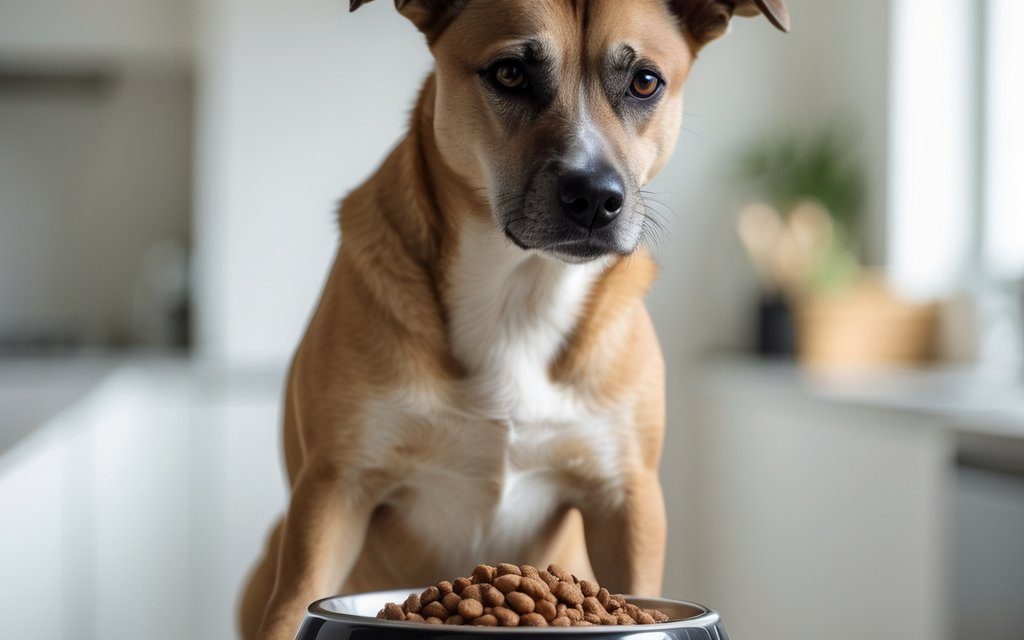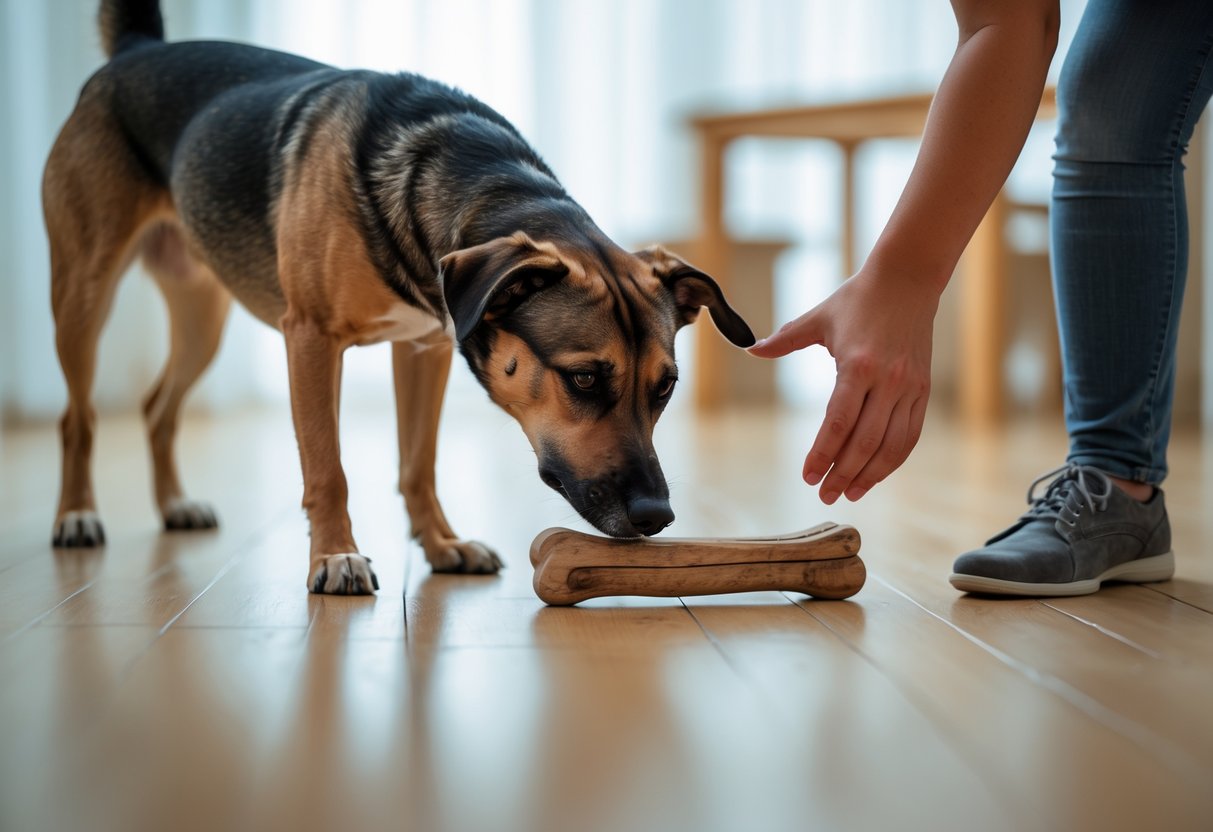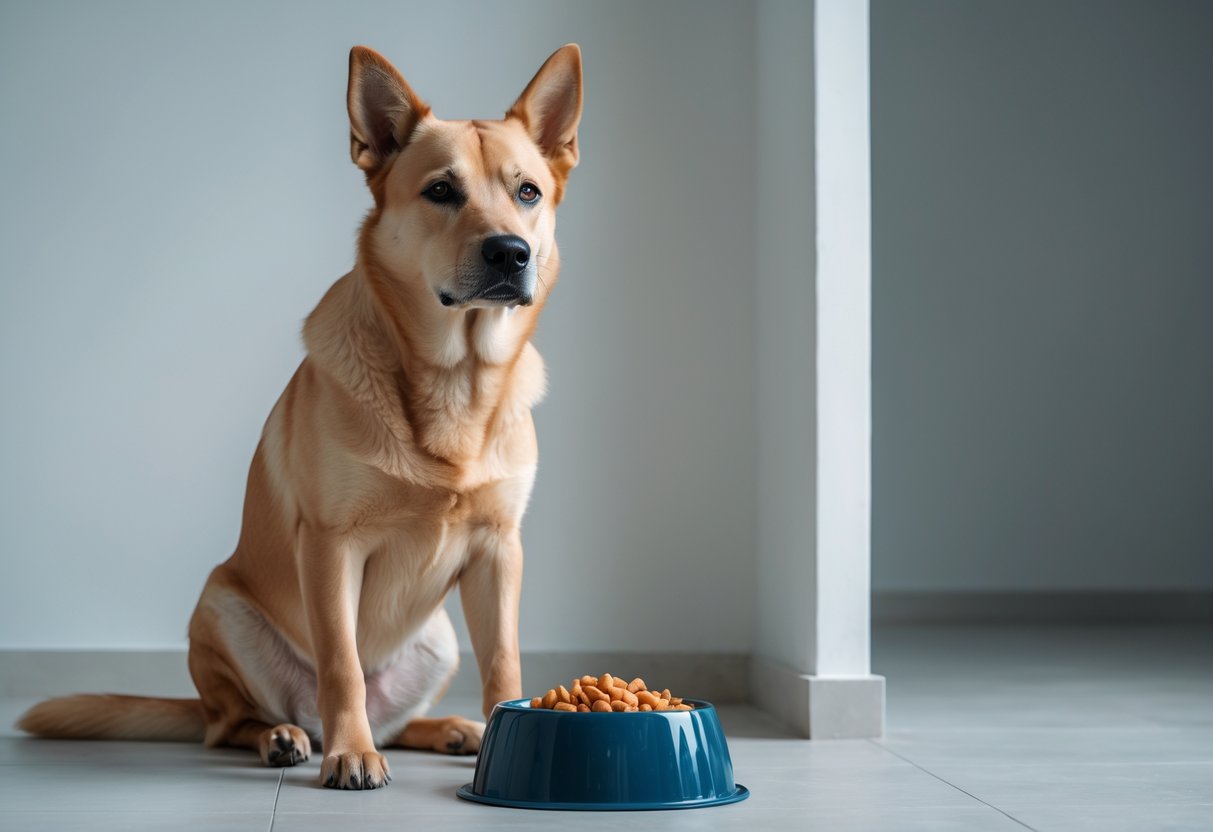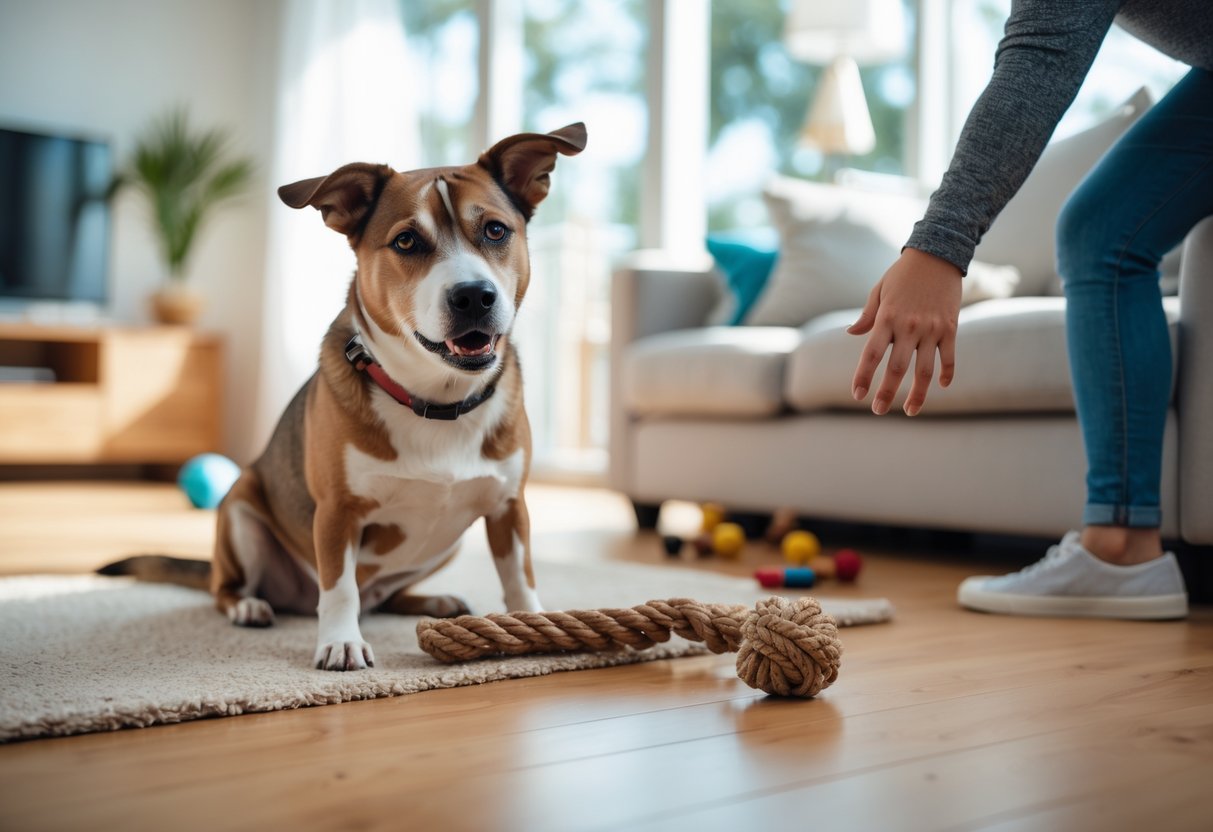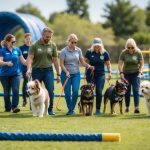Dogs sometimes protect things they love—food, toys, or even a favorite spot. This is called resource guarding, and honestly, it’s a normal thing rooted in their survival instincts.
If you can figure out why your dog does this and handle it calmly, you’ll build trust and skip a lot of stress for both of you.
You might notice your dog growling, stiffening, or snapping if someone gets close to their prized possessions. These signs can be worrying, but spotting them early is key to managing things kindly and safely.
With some patience and simple steps, you can help your dog feel secure without always needing to guard.
Key Takeways
- Dogs guard because they feel a need to protect valuable things.
- Spotting early signs helps prevent problems from getting worse.
- Kind, consistent training builds trust and reduces guarding behaviour.
What Is Dog Resource Guarding?
When your dog acts protective over certain things, it can feel confusing or even a bit worrying. This behaviour is natural but can cause issues if it gets too strong or aggressive.
Understanding why your dog guards and what they’re guarding helps you handle things calmly and safely.
The Nature of Guarding Behaviour
Dog resource guarding means your dog tries to keep others away from something they value. This can look like growling, stiffening, or even snapping when someone comes near their food, toys, or space.
It’s not about being “bad” or stubborn; it’s just an instinct to protect what matters to them.
This guarding behaviour is sometimes called possessive aggression. In the wild, dogs had to guard resources to survive, so even a pampered pet can show this instinct.
Your dog’s way of saying, “I don’t want to lose this,” might be a stiff body or a close watch. Spotting these early can help you avoid bigger problems.
Why Dogs Guard Resources
Your dog guards because they’re scared or unsure about losing something they care about. Fear and anxiety play a big part here.
If your dog has been punished or had things snatched away before, they might guard more to feel safe. A shaky routine or lack of confidence can make a dog cling to food or toys.
Dogs who aren’t sure when their next meal is coming may get extra protective. Puppies sometimes pick up guarding from their siblings, but it’s usually tied to feeling insecure.
Understanding this makes it easier to teach your dog that sharing is safe.
Commonly Guarded Items and Spaces
Dogs can guard just about anything they think is valuable. The usual suspects are food bowls, treats, and favorite toys.
Some dogs protect beds, crates, or spots where they like to chill. Others even guard people, trying to keep you or family members safe from strangers.
Random stuff—like shoes or found objects—can become treasures worth guarding. If you know what your dog guards, you can manage things better, like feeding in a quiet spot or keeping tempting stuff out of reach.
For more on how guarding works, here’s a detailed guide: dealing with resource guarding.
Recognising the Signs of Resource Guarding
Noticing how your dog shows they’re protecting something helps keep everyone safe. Some signs are obvious, but others are subtle and easy to miss.
If you know these cues, you can act before things get out of hand.
Body Language Cues
Your dog uses their body to show they feel protective. You might see them stiffen up and stand over a toy or food bowl, blocking you out.
Watch for a hard stare—that means they’re on high alert. Sometimes you’ll notice the whites of their eyes, called “whale eye,” which usually means stress.
Another sign: lifting their lips to bare their teeth. That’s a warning, often just before growling or snapping.
Freezing suddenly is another big clue—they’re unsure but want to keep their item.
By paying attention to these body signals, you’ll know when your dog feels threatened and can avoid pushing them further.
Aggressive Behaviours
Sometimes dogs get more direct to protect their stuff. Growling is a clear “back off.”
If you ignore the growl, your dog might snap—a quick, warning bite. In rare cases, this can turn into a real bite, which is definitely a sign to call in a professional.
It’s worth saying: respect growling and snapping. Pushing past those warnings just damages trust and makes things riskier.
Subtle Indicators to Watch For
Not every dog makes a scene. Some show quiet signs that they’re uncomfortable.
Your dog might avoid eye contact or walk away when they’ve got something precious. Their face may tense up, or they might freeze as you approach.
Sometimes they eat super fast or hide toys instead of playing. These little things mean your dog’s worried about losing their stuff.
If you catch these hints, you can help your dog feel safer and dodge bigger problems later.
For more, check out identifying signs of resource guarding and what to watch for.
What Causes Resource Guarding in Dogs?
When your dog guards food or toys, it’s usually because they feel a need to protect something important. This can come from instincts, past experiences, health problems, or just stress at home.
Understanding these causes helps you respond with patience and care.
Instincts and Survival Drives
Dogs naturally guard things they value—food, toys, or resting spots. This behavior comes from wild ancestors who had to defend their stuff to survive.
Some dogs just position themselves between you and their toy, while others might growl or snap. It doesn’t mean your dog is mean—they’re just trying to protect what matters.
This instinct can run stronger in dogs with uncertain pasts or those who’ve experienced scarcity. Even well-loved pets can show guarding. Some breeds or personalities (like fearful or impulsive dogs) are more prone to it.
Past Experiences and Trauma
Your dog’s history really shapes how they act around their stuff. If they’ve had to compete for food or been neglected, they may guard fiercely.
Puppies raised with lots of siblings might learn guarding early. Dogs rescued from shelters or rough backgrounds often guard because they never knew when their next meal was coming.
Sometimes, guarding pops up suddenly in adult dogs with no history of it. A big life change or stress can trigger it.
Knowing your dog’s past makes it easier to be patient and create a safe place where they can let go of their guarded items.
Health and Medical Triggers
If your dog suddenly starts guarding more, pain or illness could be the cause. Sometimes, guarding is a sign of discomfort.
Dogs with arthritis, dental pain, or other health issues might protect their space or food because they feel vulnerable. They want to rest or keep access to something they need.
A vet check is a must if guarding starts out of nowhere or ramps up fast. Treating health problems can help your dog relax and guard less.
Understanding this link helps you focus on your dog’s well-being, not just the behavior.
Environmental Stress Factors
What’s going on around your dog can make guarding worse. A noisy, crowded house or lots of changes can make your dog want more control.
Living with other dogs can increase guarding due to competition. Some dogs get anxious when people or other animals come too close to their stuff.
How you act matters, too. Taking food away suddenly or using harsh punishments can make guarding worse. Calm, respectful approaches help keep things chill.
Setting up a peaceful environment and teaching simple commands like “drop it” can help your dog feel less worried about losing what they love.
Managing Resource Guarding: Practical Strategies
Managing resource guarding takes patience and a few clear steps. You’ll want to create safer spaces, control what your dog gets protective over, and handle things carefully if you’ve got more than one pet.
These changes help your dog relax and keep everyone safe.
Controlling the Environment
First, figure out what your dog guards. Is it toys, food bowls, or a favorite spot?
Once you know the triggers, you can make things easier. For example:
- Put toys or bones away when you have guests.
- Feed your dog in a quiet area, away from busy rooms.
- Keep high-value treats out of reach unless you’re ready to use them for training.
When you control the environment, you lower the chances of your dog feeling threatened. It also gives you space to train calmly without surprises.
Setting Up Safe Spaces
Your dog needs a spot where they can enjoy their things without worry. A quiet area like a crate, a cozy corner, or behind a baby gate works well.
In their space:
- Let your dog rest or eat without interruptions.
- Don’t reach in or disturb them suddenly.
- Use the area for downtime, so your dog knows it’s their private zone.
A safe space lets your dog relax and feel secure. Over time, this helps reduce guarding because they don’t have to stay on high alert.
Managing in Multi-Pet Households
When you’ve got more than one dog, managing resource guarding gets complicated fast. Watch for signs like growling or stiff posture to catch trouble before it starts.
Here are a few things that help:
- Feed dogs separately, maybe in different rooms if you can swing it.
- Hand out toys and treats one at a time to keep things fair.
- Stick around and keep an eye on them during play or downtime.
If you spot guarding, try redirecting with commands like “leave it” or “drop it.” Teaching patience and sharing takes time, but it does help keep the peace.
How to Stop Resource Guarding in Dogs
Stopping resource guarding is really about helping your dog feel safe when you come near their stuff. Change how your dog sees your approach to their food, toys, or space, and you’ll build trust.
The ‘Add Value on Approach’ Method
This one’s all about teaching your dog that you coming near their food or toys is a good thing. Grab some treats your dog loves. When they’re nearly done eating, quietly drop a few treats near the bowl and step away.
Do this for a few meals. Gradually, start dropping treats closer while they’re still eating. Eventually, you’ll be able to drop treats right into their empty bowl—your approach means more rewards, not loss.
Patience is key here. Don’t rush it, or you’ll just make things worse. If you keep it positive, your dog will eventually relax when you’re nearby at mealtimes.
Teaching ‘Drop It’ and ‘Leave It’
These commands give you a gentle way to manage things. Start while your dog is playing with a toy. Offer a better toy or a tastier treat a little ways away, and most dogs will drop what they have to check out the new offer.
When your dog drops the item, say “drop it” or “leave it,” then hand over the treat or toy right away. They’ll start to connect the word with the action—and realize letting go is actually a good deal.
Keep practice sessions short and fun. Give the first toy back after swapping, so your dog learns that dropping something doesn’t mean it’s gone forever.
Reward-Based Training Techniques
Rewards—treats, praise, whatever your dog likes—work wonders. Don’t punish your dog for guarding; it only ramps up anxiety. Instead, reward calm behaviour around their favorite stuff.
Try short training sessions where your dog gets a treat for staying relaxed near toys or food. Keep your voice soft and movements slow. If your dog tenses up, give them space and try again another time.
Stick with the same cues and reward every time they stay calm. Over time, your dog learns sharing is safe, not risky. For more tips, check out how to stop your dog resource guarding food and toys.
Preventing Resource Guarding for the Future
Preventing guarding starts with trust and clear, positive routines. Build your bond and use early training techniques to lower the odds of guarding showing up. Good experiences around their resources help your dog feel safer and more relaxed.
Building Trust With Your Dog
Trust is everything here. Your dog needs to feel safe when you’re near, especially around their food or favorite toys.
Spend quiet time next to your dog while they eat, but don’t take anything away. Instead, approach the bowl, drop a treat nearby, and step back.
Do this often. Your dog will start to expect treats and relax more when you approach.
Early Training and Socialisation
Start training young if you can. Early socialization with other dogs and people helps your dog feel more confident in all sorts of situations.
Teach basic commands like “leave it” and “drop it” early on. These commands give you tools to handle tricky moments. Use treats and praise when your dog does well.
Try gently handling their favorite things. Take a toy or food away briefly, then trade it for a treat. Your dog learns that losing something isn’t a big deal.
Establishing Positive Associations
You want your dog to think that changes to their resources are a good thing. Prove to them that sharing or giving up items means rewards.
Give treats near their toys or food bowl. Add a little extra food to their bowl during meals. Your dog will start to see you coming as a good sign.
Practice swapping items by offering a treat for a toy. Stay calm and gentle—no need for drama. This makes your dog more likely to cooperate, and less likely to guard in the future.
For some extra help, check out the advice on dealing with resource guarding.
Frequently Asked Questions
When your dog guards their stuff, it’s stressful. But knowing what to look for and how to help makes things easier. There are ways to teach your dog to chill out about sharing.
How can you tell if your pooch is guarding their resources too aggressively?
Watch for growling, snapping, or a stiff stance when you or someone else gets close to their food, toys, or favorite spots. These are signs your dog feels threatened and wants to protect what matters to them.
What steps should you take to help your furry friend feel more at ease about sharing?
Start by keeping things calm and avoid sudden moves near their stuff. Use treats and praise when they stay relaxed as you approach. This helps build trust and shows them sharing isn’t scary.
Can teaching your dog to ‘leave it’ or ‘drop it’ help with resource guarding behaviours?
Absolutely. These commands help your dog understand when you want them to let go of something. They give you a clear, positive way to manage their behavior.
What do you do if your dog snaps at other pets or people over toys or food?
Don’t punish harshly—it just makes things worse. Calmly separate them and work on slow, steady training to reduce their need to defend stuff.
How can you safely intervene when your dog is displaying guarding behaviour?
Keep your distance and don’t grab for their things. Use commands like ‘leave it’ and offer a trade—something they like better. This helps avoid a fight and keeps everyone safe.
Is it possible for puppies to learn resource guarding, and how can you prevent it?
Yep, puppies can start guarding pretty early on. You can help prevent it by sharing resources gently and often.
Give your puppy lots of positive experiences with people around their food and toys. Early socialisation goes a long way—most pups just need to feel safe and confident, honestly.
If you want more tips on handling this, here’s a good read: understanding resource guarding in dogs.


